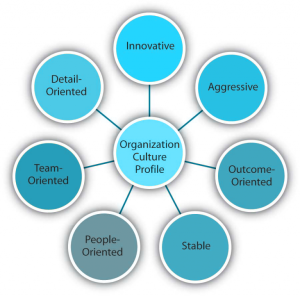15.1 Characteristics of Organizational Culture
Learning Objectives
- Discuss the different dimensions of organizational culture.
- Describe cultural strength.
- Explore subcultures within organizations.
Dimensions of Culture
Which values characterize an organization’s culture? Even though culture may not be immediately observable, identifying a set of values that might be used to describe an organization’s culture helps us identify, measure, and manage culture more effectively. For this purpose, several researchers have proposed various culture typologies. One typology that has received a lot of research attention is the organizational culture profile (OCP), in which culture is represented by seven distinct values (Chatman & Jehn, 1991; O’Reilly, Chatman, & Caldwell, 1991). We will describe the OCP as well as two additional dimensions of organizational culture that are not represented in that framework but are important dimensions to consider: service culture and safety culture.

Innovative Cultures
According to the OCP framework, companies that have innovative cultures are flexible and adaptable and experiment with new ideas. These companies are characterized by a flat hierarchy in which titles and other status distinctions tend to be downplayed.
Aggressive Cultures
Companies with aggressive cultures value competitiveness and outperforming competitors: By emphasizing this, they may fall short in the area of corporate social responsibility.
Outcome-Oriented Cultures
The OCP framework describes outcome-oriented cultures as those that emphasize achievement, results, and action as important values. Outcome-oriented cultures hold employees as well as managers accountable for success and utilize systems that reward employee and group output. In these companies, it is more common to see rewards tied to performance indicators as opposed to seniority or loyalty. Research indicates that organizations that have a performance-oriented culture tend to outperform companies that lack such a culture (Nohria, Joyce, & Roberson, 2003). At the same time, some outcome-oriented companies may have such a high drive for outcomes and measurable performance objectives that they may suffer negative consequences. Companies that overreward employee performance, experienced well-publicized business and ethical failures. When performance pressures lead to a culture where unethical behaviours become the norm, individuals see their peers as rivals and short-term results are rewarded; the resulting unhealthy work environment serves as a liability (Probst & Raisch, 2005).
Stable Cultures
Stable cultures are predictable, rule-oriented, and bureaucratic. These organizations aim to coordinate and align individual efforts for the greatest levels of efficiency. When the environment is stable and certain, these cultures may help the organization be effective by providing stable and constant levels of output (Westrum, 2004). These cultures prevent quick action, and as a result, may be a misfit to a changing and dynamic environment.
People-Oriented Cultures
People-oriented cultures value fairness, supportiveness, and respect for individual rights. These organizations truly live by the mantra that “people are their greatest asset.” In addition to having fair procedures and management styles, these companies create an atmosphere where work is fun and employees do not feel required to choose between work and other aspects of their lives. In these organizations, there is a greater emphasis on and expectation of treating people with respect and dignity (Erdogan, Liden, & Kraimer, 2006).
Team-Oriented Cultures
Companies with team-oriented cultures are collaborative and emphasize cooperation among employees. In team-oriented organizations, members tend to have more positive relationships with their coworkers and particularly with their managers (Erdogan, Liden, & Kraimer, 2006).
Detail-Oriented Cultures
Organizations with detail-oriented cultures are characterized in the OCP framework as emphasizing precision and paying attention to details. Such a culture gives a competitive advantage to companies in the hospitality industry by helping them differentiate themselves from others. For example, Four Seasons Hotels Ltd. and the Ritz-Carlton Company LLC are among hotels that keep records of all customer requests, such as which newspaper the guest prefers or what type of pillow the customer uses. This information is put into a computer system and used to provide better service to returning customers. Any requests hotel employees receive, as well as overhear, might be entered into the database to serve customers better. Recent guests to Four Seasons Paris who were celebrating their 21st anniversary were greeted with a bouquet of 21 roses on their bed. Such clear attention to detail is an effective way of impressing customers and ensuring repeat visits. (Fitch, 2004; Ford & Heaton, 2001).
Service Culture
Service culture is not one of the dimensions of OCP, but given the importance of the retail industry in the overall economy, having a service culture can make or break an organization.
What differentiates companies with a service culture from those without such a culture may be the desire to solve customer-related problems proactively. In other words, in these cultures, employees are engaged in their jobs and personally invested in improving customer experience, such that they identify issues and come up with solutions without necessarily being told what to do. For example, the London Club (londonclub.com) is a private dining club in the city of London. When the GM, Geoff Curphey, was asked about service culture, he said their club lives by a simple service motto: “The answer is Yes! What is the question?”(G. Curphey, personal communication, July 7th, 2025). This is a reminder to all staff of the elevated service standards that are the foundation of the organization.
Strength of Culture

A strong culture is one that is shared by organizational members (Arogyaswamy & Byles, 1987; Chatman & Eunyoung, 2003). In other words, if most employees in the organization show consensus regarding the values of the company, it is possible to talk about the existence of a strong culture. A culture’s content is more likely to affect the way employees think and behave when the culture in question is strong. For example, cultural values emphasizing customer service will lead to higher quality customer service if there is widespread agreement among employees on the importance of customer service-related values (Schneider, Salvaggio, & Subirats, 2002).
It is important to realize that a strong culture may act as an asset or liability for the organization, depending on the types of values that are shared. For example, imagine a company with a culture that is strongly outcome-oriented. If this value system matches the organizational environment, the company outperforms its competitors. On the other hand, a strong outcome-oriented culture coupled with unethical behaviours and an obsession with quantitative performance indicators may be detrimental to an organization’s effectiveness. An extreme example of this dysfunctional type of strong culture is Enron.
A strong culture may sometimes outperform a weak culture because of the consistency of expectations. In a strong culture, members know what is expected of them, and the culture serves as an effective control mechanism on member behaviour. Research shows that strong cultures lead to more stable corporate performance in stable environments. However, in volatile environments, the advantages of cultural strength disappear (Sorensen 2002).
Do Organizations Have a Single Culture?
So far, we have assumed that a company has a single culture that is shared throughout the organization. However, you may have realized that this is an oversimplification. In reality, there might be multiple cultures within any given organization. For example, people working in the pro shop may experience a different culture from that experienced by people working in food and beverage. A culture that emerges within different departments, branches, or geographic locations is called a subculture. Subcultures may arise from the personal characteristics of employees and managers, as well as the different conditions under which work is performed. Therefore, in addition to understanding the broader organization’s values, managers will need to make an effort to understand subculture values to see their impact on workforce behaviour and attitudes. Moreover, as an employee, you need to understand the type of subculture in the department where you will work, in addition to understanding the company’s overall culture.
Exercises
- Think about an organization you are familiar with. Based on the dimensions of OCP, how would you characterize its culture?
- Out of the culture dimensions described, which dimension do you think would lead to higher levels of employee satisfaction and retention? Which one would be related to company performance?
- What are the pros and cons of an outcome-oriented culture?
- Can you imagine an effective use of subcultures within an organization, especially in golf and clubs?
“15.3: Characteristics of Organizational Culture” from Organizational Behavior by LibreTexts is licensed under a Creative Commons Attribution-NonCommercial-ShareAlike 3.0 International License, except where otherwise noted.

